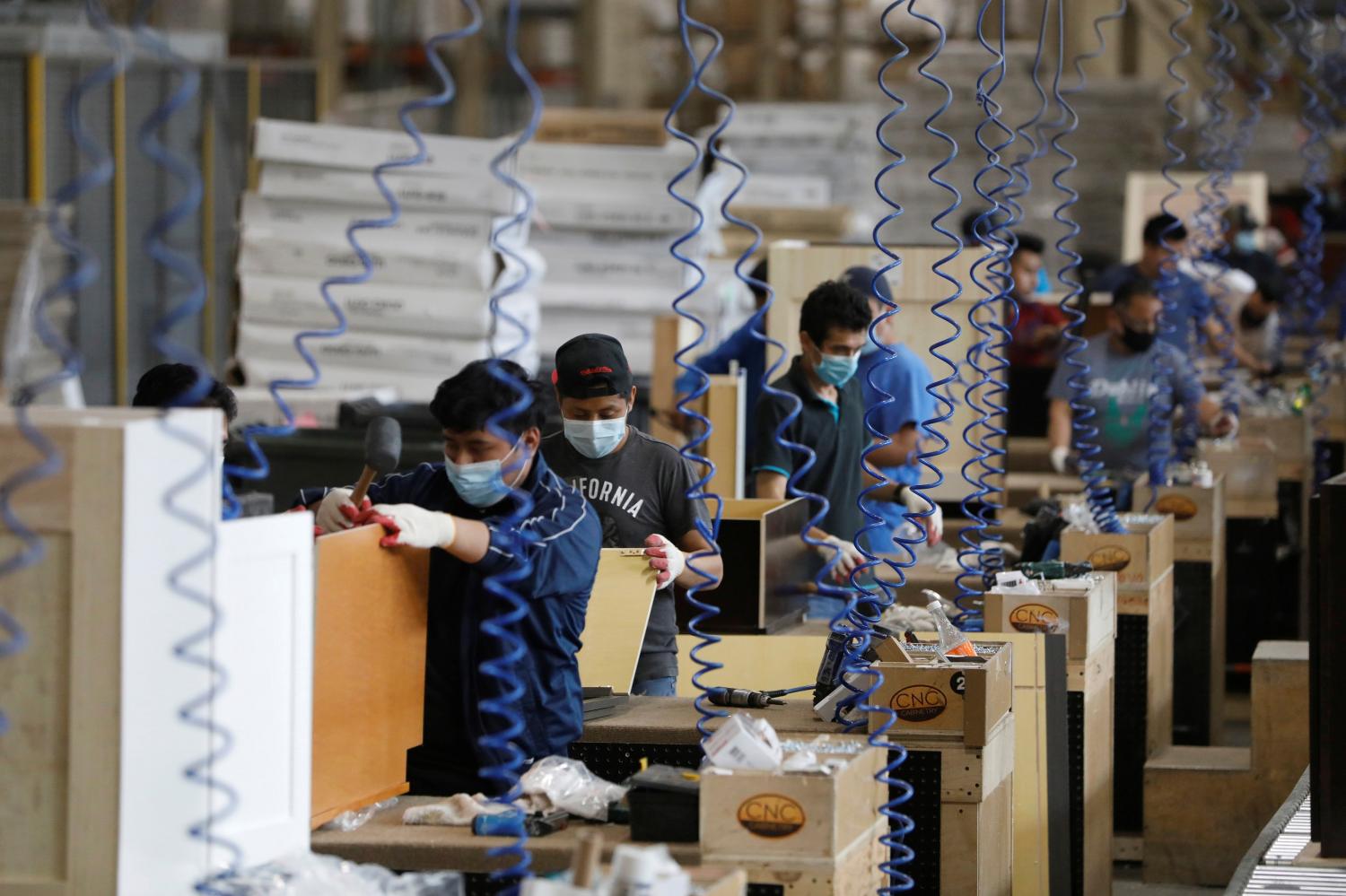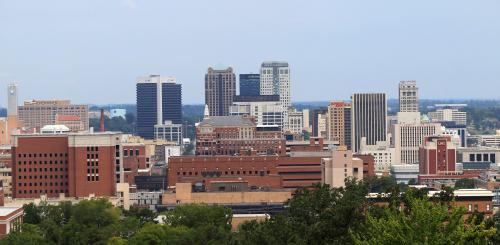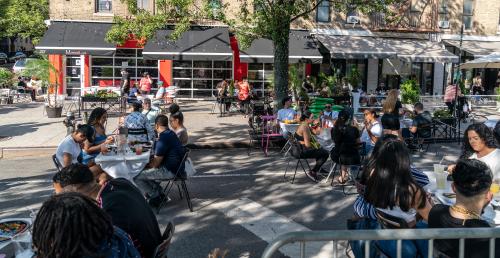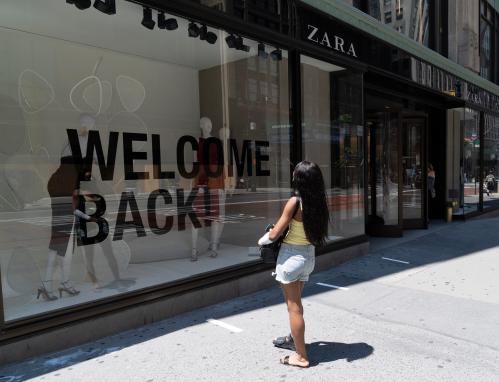The following is an excerpt from Reopening America: How to Save Lives and Livelihoods, a new report where Brookings experts offer ideas to help policymakers protect lives and save livelihoods in the midst of the current COVID-19 pandemic.
 Faced with the staggering economic fallout of the COVID-19 pandemic, state and local leaders are exploring how and when to lift stay-at-home orders and reopen local economies. Unemployment rates have skyrocketed and job losses rival those of the Great Depression. Leaders are also confronting the health risks that reopening poses for workers, their families, and the community— risks exacerbated by inadequate testing, shortages of personal protective equipment (PPE), weak enforcement of workplace safety standards, and no readily available treatment or vaccine. The rising death toll of essential workers such as nurses, bus drivers, and grocery workers is a grave reminder of what is at stake in these decisions.
Faced with the staggering economic fallout of the COVID-19 pandemic, state and local leaders are exploring how and when to lift stay-at-home orders and reopen local economies. Unemployment rates have skyrocketed and job losses rival those of the Great Depression. Leaders are also confronting the health risks that reopening poses for workers, their families, and the community— risks exacerbated by inadequate testing, shortages of personal protective equipment (PPE), weak enforcement of workplace safety standards, and no readily available treatment or vaccine. The rising death toll of essential workers such as nurses, bus drivers, and grocery workers is a grave reminder of what is at stake in these decisions.
As leaders across the country seek opportunities to put laid-off workers back to work, their decisions will have an outsized impact on lowwage workers and people of color, who shoulder some of the most severe financial and health burdens associated with the coronavirus and will be some of the first workers called back to the job site. Leaders must create the conditions for a more equitable next phase of the pandemic so that low-income and minority workers are not forced to make an impossible choice between surviving financially or surviving the virus.
COVID-19 JOB LOSSES HIT LOW-WAGE WORKERS AND PEOPLE OF COLOR THE HARDEST
Low-wage workers in America have suffered the worst economic pain of the pandemic. Social distancing measures taken in response to COVID-19 resulted in massive job loss concentrated among lower-wage workers. Retail and leisure/hospitality, which typically offer lower wages than other industries, took the hardest hits. In April, retail posted a 17.1 percent unemployment rate, totaling 3.2 million people. In leisure/hospitality, the unemployment rate was a staggering 39.3 percent, totaling 4.8 million people.
Workers with the least education have suffered the most. In April, unemployment rose to 21.2 percent for those with less than a high school degree—more than twice as high as the 8.4 percent unemployment rate for those with a bachelor’s degree or higher. Financial shocks and unemployment are widespread, but Black and Latino or Hispanic workers are disproportionately affected.
One of the reasons low-wage workers have suffered disproportionate job losses is their limited ability to telework. Low-wage workers are six times less likely to be able to work from home than high-income workers. Fewer than 10 percent 31 of leisure and hospitality workers can telework, while a majority of workers in higher-paid fields such as the finance, business, professional, and information sectors can. The vast majority of workers who held jobs just a few weeks ago in restaurants, bars, gyms, salons, movie theaters, and malls could not perform those jobs from home once the pandemic started and were laid off as social distancing requirements caused many of those establishments to close.
Low-wage workers in America have suffered the worst economic pain of the pandemic. Social distancing measures taken in response to COVID-19 resulted in massive job loss concentrated among lower-wage workers.
As cities and regions across the country start to reopen businesses, millions of laid-off, low-wage workers face a dual dilemma. To earn a paycheck, the vast majority will have to show up physically to work, risking exposure to the coronavirus. But their pay could be less than the already low wages they earned before, and even less than what they were collecting through enhanced unemployment insurance at the beginning of the pandemic. Servers may return to half-empty restaurants and far smaller tips, for instance, and hours for low-paid retail and leisure workers may be cut. As their eligibility for unemployment benefits expires, many may find themselves in the difficult position of choosing between their health and their (potentially even smaller) paychecks.
LOW-WAGE WORKERS AND COMMUNITIES OF COLOR ALSO FACE HIGHER HEALTH RISKS
The coronavirus is an unequal killer. Low-income and minority populations face a higher risk of dying from COVID-19 due to structural conditions, health inequities, and a higher prevalence of preexisting health conditions such as heart disease, asthma, and diabetes. The mortality rate from the virus is nearly three times higher for Black Americans than for whites. According to an analysis by the Kaiser Family Foundation, a far higher percentage of low-income, non-elderly adults have a serious risk of dying from COVID-19 than higher-income adults.
Community spread is also a real concern. As they risk exposure on the job site, low-wage workers are also risking the health of the family members they live with. Low-wage workers are more likely than those with higher incomes to live in households of at least five people and with someone over the age of 60. Multigenerational households are also nearly twice as common in communities of color than among non-Latino or Hispanic whites.
GOVERNMENT MUST TAKE A MUCH STRONGER ROLE ENSURING THE HEALTH AND SAFETY OF WORKERS
The priority for policymakers and employers must be to keep workers safe and protected on the job. The federal government should have enacted enforceable safety requirements for employers, but it has not, and the administration appears unlikely to do so. The Centers for Disease Control and Prevention (CDC) and the Occupational Safety and Health Administration have both released guidelines for workplace safety, but they are advisory in nature. State and local governments should create and enforce their own requirements based on the guidance from those agencies.
So far, employers’ track record on worker safety during the pandemic is concerning. The shocking outbreaks in meatpacking plants across the country are a reminder of the potential hazards that workers face on the job. A survey from the University of California at Berkeley revealed uneven and often inadequate safety procedures across major industries that employ lowwage workers, including retail, warehousing, restaurants, hotels, and pharmacies. Several walkouts and strikes among gig workers and warehouse workers have highlighted urgent concerns about safety, but workers in general have limited ability to advocate more protection.
Many businesses simply will not take the necessary steps to protect their employees unless forced to by government, workers, or perhaps consumers. Companies often treat low-wage or frontline workers as costs to be minimized rather than people and assets to protect. In the absence of federal action, state and local leaders should strengthen protections for workers and create new avenues for them to report safety concerns without risk of retaliation.
Critical shortages of PPE have already impacted first responders and health workers, prompting the CDC to issue guidance acknowledging the “tremendous challenge” that shortages are posing to the U.S. healthcare system. These shortages will become even more urgent as workers return to the job site and the demand for masks, gloves, and sanitizer grows. The federal government should utilize the Defense Production Act to increase the PPE supplies.
GOVERNMENT SHOULD ASSIST WORKERS WHO CAN’T (OR SHOULDN’T) WORK
State leaders should take extra measures to provide a safety net to the workers who are at greatest risk from COVID-19. No matter what safety measures employers put in place in the coming months, it may simply be too dangerous for some of the highest-risk workers to return to the workplace until a vaccine is available. The CDC has identified higher-risk individuals as people over age 65, people with underlying medical conditions including lung disease and severe asthma, and those who are immunocompromised due to other medical conditions. Low-income workers and workers of color are more likely to have these underlying medical conditions.
State leaders can follow the lead of the Texas Workforce Commission and issue guidance clarifying that unemployed workers can refuse rehire and remain eligible for unemployment benefits if they or a household member is at especially high risk from COVID-19. According to the new Texas guidance, other approved reasons for refusal could include a COVID-19 diagnosis, quarantine, or lack of child care.
GOVERNMENT NEEDS TO ASSIST WORKERS WHO LOST WORK OR INCOME
Massive unemployment requires a proportionate response. Even as states reopen, the scope and pace of hiring will be nowhere near enough to compensate for the tens of millions of jobs lost in the past few months. The federal government has taken important initial steps in the Families First Coronavirus Response Act and the Coronavirus Aid, Relief, and Economic Security Act, but the unemployment benefits they provide are too limited in length and exclude some of the most vulnerable working families, including immigrants. More needs to be done to provide direct relief to the millions of workers and families who risk financial ruin and could plunge deeper into poverty. One promising proposal in Congress calls for automatic extension of unemployment relief through the period of extreme social distancing and economic crisis.
The federal government should also enact a large scale, federally funded employment initiative to employ millions of people, and authorize such a program for at least three years. The program could place subsidized workers at nonprofits and businesses, and directly employ people in the public sector in emergency response, public works, and infrastructure jobs. It could place workers in jobs that aid the COVID-19 relief effort, such as contact tracing, making and distributing PPE, organizing food drives, and delivering groceries to those who are homebound. Of course, any of these employment opportunities should be safe, allowing for adequate social distancing as well as any necessary PPE.
The coronavirus has laid bare the inequities of our labor market and health system and the weaknesses of our safety net, leaving the country’s most vulnerable workers and families on the edge of financial disaster. In the near term, the focus of policymakers at all levels of government should be on keeping workers safe and protected 34 on the job, extending the safety net for those who cannot or should not work, and providing economic relief and work to the millions of workers who lost jobs and income. In a heartening move, some states, cities, and regions are making explicit commitments to equity as they respond to the COVID-19 crisis. Addressing the inequities that existed long before the pandemic requires immediate policy responses, as well as long-term, structural change for a better, more resilient future for all workers.








